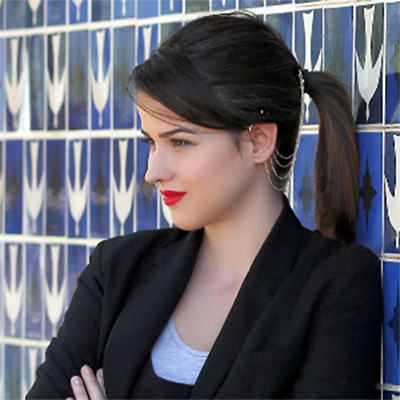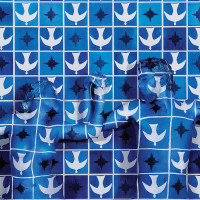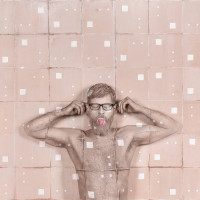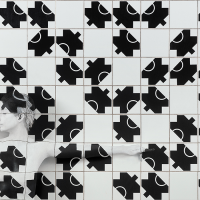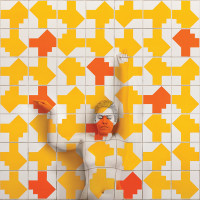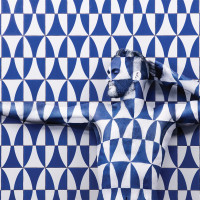Interview: Ana Siqueira
Written by Fernanda, Posted in ART, FASHION, FOOD, INTERVIEWS, LIFESTYLE
This week’s interviewee is Brazilian make-up artist Ana Siqueira.
If someone asked me to describe the way I see her, I would say she transmits a rare and admirable authenticity, resiliency and great passion for her work. I believe this is an important combination that makes Ana a successful professional and someone to be admired. I am sure you will be able to see this as well through this interview.
I think that all of us from Brasília can’t help but feel proud of having an artist interpreting the iconic work of Athos Bulcão in such a beautiful and creative way [through her project Habitathos]. In my case, there is also an extra especial reason, since my family used to live in the Quadra 308 Sul in Brasilia, right next to where the The Little Church of Our Lady of Fátima is located, and which has Athos Bulcão’s work on its outside walls.
I hope you all enjoy her story, and also all the great images from her Habitathos project, her work as a make-up artist, and all the great tips regarding her favorite spots in the city.
Ana, thank you for the interview! It was a pleasure, and I wish you even more success!
You are a make-up artist. Tell us a little bit about your projects and how a typical work day is for you here in NY.
Besides the Habitathos project, I work with fashion and commercial make-up. Fashion editorials and videos, printing, commercial; pretty much a typical makeup artist life.
As far as the work in fashion goes, it all consists of a more daring and over-the-top make-up, with a more defined beauty, lots of smokey eyes, edgy colors. Something you don’t usually wear on a daily basis; something more conceptual in the beauty world.
When working on a commercial level, the challenge lies on providing a great skin, healthy look, and subtle beauty. The key words are: natural, believable and invisible – especially with all the technological developments we have been seeing when it comes to filming in high definition. This can be a real challenge for a make-up artist, especially the ones who love fashion make-up, because it represents a twist in its esthetical values. I feel lucky for loving both worlds; I can easily connect and disconnect with the “dramatic make-up” segment. I actually think that making the famous “ ‘no makeup’ makeup” is not exactly easy. I work mainly with three segments: artistic, fashion, and commercial.

Regardless of the type of work I will be doing here in NY, most of the time it all starts very early in the day. It involves spending a good time preparing the concept and organizing my kit the day before, as well as taking heavy cases with me around town, spending a lot of hours standing on my feet, and, sometimes, working without being able to stop to eat or go to the restroom (especially when working in fashion). There is a huge pressure to finish several looks in just one session. I would call it an “exhausting reward”, and I love it all. Well, except for maybe having to carry the heavy cases when I decide to take the subway to go to work.
How did the Habitathos project come together?
The project, as it is today, was born this past April. I made the pilot last year, with another photographer, but wasn’t happy with the partnership and concept, and decided to change. I called Celso Junior, a more intimist photographer and whom I knew better. I also changed the concept and framing. I decided to bring the pictures closer and called real people to work on the new concept. I was working with models before, and now I am working with real people. I also ended up changing its name to Habitathos.
Where did the idea come from? Where did you find your inspiration?
It’s a crazy thing, I think. It’s life and art; blending people to the environment. The inspiration came from Athos Bulcão’s work, whose art is the best to base such project on. His work is geometric, has a relevant pattern… And I am simply crazy about it; I just find everything to be so pretty! His minimalistic and graphic approach is one of the biggest influences in my sense of design. I truly think it is all very pretty and not valued enough.
I have met very few people who were passionate about Athos Bulcão. I have met architects and people who understand about art, and know what a genius he was, but at the same time, I have also seen a lot of people that simply ignored his work. People who work at a place that has his art, people who live next to one of his creations, others who pass by one of his works and just don’t know to whom it belongs to. Many don’t have any idea whatsoever that he is one the very few tile artists in the world to apply modernism and graphism to their work the way he did. He was a genius! He actually has a disciple, Alexandre Mancini, from Belo Horizonte [Brazil]. But his style is not the same. His creations sort of resemble kaleidoscopes – it is inspired, but is different. There is nothing out there like Atho’s work. And like I said, people don’t value it as they should, and whenever I would show Athos Bulcão’s work here in the United States people would go crazy! “ What is this? Is this a wall?” They simply loved it here.
PS: Please click on the squares to enlarge the images
What is the intention behind this project?
I wanted to bring people inside his work with this project because I think it is the best way to express what people feel about his work; be it, be with it, have it, be there… you know? So I decided to paint it. Take a picture and paint it. And I wanted these people to connect with the panel’s concept. And when I do it, I think it looks pretty. LOL
You have a Bachelor degree in Psychology. How did the transition to make-up happen?
I actually enjoyed studying Psychology when I was in Brazil, I just didn’t like the career perspective. Back in the day, I thought about doing my PhD here in the US. But when I was about to graduate, I fell in love with make-up. I worked as a psychologist, did all internships and post-graduation course in Neuropsychology at the same time as my undergrad. I then started thinking that it was going to take too long to get my PhD and that it would all be very repetitive – believe or not, my undergrad curriculum was actually 80% similar to the PhD one here in America. Since make-up became one of my interests, I started considering working with it while I was still doing my doctorate. I convinced myself at that time that it was only going to be a “temporary” thing – it was my way of allowing myself to work with something outside the field I had graduated on and had invested so much.
I was interning in psychology at the time, but it was very boring to work in a cubicle doing the same things every day. I knew that, despite the fact that I loved what I was studying, it was all going to bore me a lot in the long-term. The Neuropsychology field was very interesting to study and research. It was quite challenging, but the work at the clinic was very repetitive, pure drudgery. It was no surprise that, even though I loved the theoretic side of it, the practical part was quite discouraging. I always had to drag myself to work.
I wanted to have new challenges, work with a team and socialize more; something more social and diverse. My creative, artistic side has always been a strong one but I never had the validation to look at it as something vocational. My favorite class when I was in high school was arts [and biology as well], and looking back, when I see my grades back then, those [arts] were the highest ones I had. No one at the time interpreted it as a career path. I had to give myself this “authorization” because being an artist is not an option when you are part of the Brazilian society where I was raised. The only person that actually noticed my artistic side from an early age was my teacher, Miss Illona – she was Canadian. She invited me to teach art to her 1st graders in my old school – Escola das Nações. So for a full week, once a year, from my 14’ s-16, I did that with her.
You mentioned in your website that when Guilherme, your bother, opened a MAC branch in Brasília, that it was one of the things that influenced you to take make-up into consideration again.
I used to play a lot with it when I was a kid. The cliché applies to my story as well (lol). I remember, when I was around 9, one of my best-friends gave me a Christmas present, and told me that she had put this little bag with some make-up together for me because she didn’t know what to give me, but she knew I really enjoyed playing with make-up. That’s when I first realized that I really liked make-up. Even though I barely used it on myself, I really enjoyed playing with it. I still don’t wear a lot of makeup. I used to love playing with my friends and doing their make-up. And I started having this feeling again once Guilherme opened the MAC branch. Youtube also played an important part as well, once make-up artists started posting several videos teaching other people how to do their make-up. I used to live at a croft in Brasilia with my father, and we didn’t have internet at home – not even a mobile one, the reception was awful. So, I used to download the videos from youtube while I was at the gym, and would watch it at home before going to bed. I started doing it in 2008, and I still do it, religiously. I wanted to learn how to do it so I could work at the MAC store, but my ambition skipped that part and ended up taking me farther.

How was moving to NY and focusing on a new career path?
I had already taken some make-up classes in Brazil [at SENAC], and was already working a little with it. It was a low-profile work, only doing it with friends and people I knew. I came to NY and went to MUD [Make-up Designory]. I then started working with fashion and commercial. Establishing yourself in this market and in a different country can be described as a true battle. It is a liberating thing to work as a freelancer, but it is a very hard thing to do it here in the US. It all depends on having a good credit and high income, and we got here with no credit history or income; only the money we had saved before moving here. We had to adjust to a lot of cultural changes, trying to open new doors and create opportunities, all at the same time. You need to be very persistent to establish yourself in this business. This is a highly competitive field, each detail has to be very well executed and will be quite relevant in order to allow you to have a chance. If I weren’t so organized, persistent, and hadn’t organize all my finances in advance to go through this, I don’t think I would have been able to stand such an intense life in NY.
How did you feel when you actually started working as a make-up artist? Was it what you had expected?
It’s fifty thousand times more challenging than I expected! As far as the competition goes, I think no one can beat NY. There are just so many bad people working in this field that they make it more difficult for you to show potential clients your expertise – agencies, employers, and clients are all fed up with all the bad professionals. The amount of people without proper skills trying to make it is just so overwhelming that it is hard to break the barrier between potential employers and employees. It takes a lot longer for you to be able to prove yourself. You need to be persistent and focus on what you want. I was, and since the beginning, I had some money saved to invest on the material, and on my advertising and branding. One other thing that I saw in my make-up business class at MUD and that really shocked me at the time was the idea that fashion pays well. They asked: “How much do you think Vogue pays their make-up artist for the cover of Vogue Italia?” People in my class would then guess; a thousand, five, ten thousand! And our teacher would say: “200 hundred, if much! And be happy with it! It is only supposed to cover your transportation, costs, and whatever remains is for the time you spent working there.”
You taught yourself a lot of things. How have you been applying it as a business strategy?
I am very DIY [Do It Yourself]. I made my own logo, my own portfolio case – with the help of a friend and her camera. I take care of my website. I think it all helped things become quite cohesive, and that differentiates me [from others in her field]. My business for make-up class was one of the most important for me. Was it challenging? Yes. But I think things have been better for me than for the ones who started around the same time I did. I think managing your work properly is a pivotal thing; marketing, professionalism, and other pragmatic issues. I don’t add anything that is not at a certain level to my portfolio; if the image is not properly treated or the model beautiful enough, I will not add it to it. Fashion requires it, and having this type of criteria makes all the difference. This is where having a good sense of esthetic helps and speeds things up for the ones who are trying to establish themselves in the market.
Youtube played a really big part when it came to learning and understanding things, especially the ones related to technology in the art field. I’m now learning how to do image retouching. That’s how I have been expanding things from a make-up perspective to a digital artist one. Sometimes I send some work to some people but the results don’t always end up being the way I expect them to, so I have decided to learn how to do it myself. I learned how to work with vectors, for example, because I needed it for the Habitathos project. I just love learning new things.
Is there a project, other than Habitathos, that has left a special mark?
They all leave a mark, honestly. I am always very excited when I have the opportunity to work on girls who are incredibly competent models and/or when I can work with big photographers and directors, who are, above all, great people. Exceptional people to work with and that can completely turn a day at work into something even more pleasant than the usual. Of course, I have had bad experiences as well, like when a client decided to drink more than advised, a model who had been scheduled for a shoot and didn’t show up. When this last incident happened, we had to make it work with another model after she already had tons of makeup done by another professional. This was one huge challenge regarding time management and skills to leave her face clean and change her hair and makeup 5 times in less than 2.5 hours. There are several other stories of resiliency and improvisation. I always feel very enthusiastic when I start working with a new client.

How is your relationship with the city of NY?
I love NY. It’s been a while now since I started feeling like a true New Yorker. I think it starts with the moment you stop glamorizing the city and realize “NY is a bit–!” (LOL!). I like it here. I think what makes it stand out for me is that people are not always trying to take advantage of you here. You are always feeling defensive and insecure when you are in Brazil, because you know there will always be someone with not so noble intentions trying to take advantage of you and everything. If someone here asks you how much something costs, they are not going to deceive you and tell you a bigger or lower price, according to their interest. They tell you the truth, for better or worse; sometimes it even feels cruel.
Professionally speaking, it is also very good in that sense. People know how to give feedback here. They accept the feedback and don’t take things so personally. There is more meritocracy here than in Brazil. There is way too much diplomacy in Brazil. Of course there is nepotism happening here, as well as people being referred to jobs, but it is not the same thing. Here in the US they will ask you to show your work and you will spend three months interning for free. At the end, if they like what they saw, they will hire you. This does not mean they are taking advantage of their intern. These little things related to moral and ethics make all the difference. I am far from saying the United States is a perfect place, but I really like to live here, especially because of work-related issues.
Besides the Habithatos project, what else do you have planned for the future? What else can we expect from you?
This is actually a very, very big project. It involves several phases and once I finish it, I am planning on launching a book. If everything goes according to plan, and if I get the fundings to do it. It keeps getting bigger every day, and I have to keep adding people to the project. Managing it all from a different country can be quite challenging. As much as I can count on other people to help me out, no one takes care of it they way I do. So, as I said, it is quite challenging. I’m thinking of investing on other projects and ideas once this project is done, but I can’t really talk about it yet, or someone could steal my ideas. LOL
But do you intend to stay in NY and continue working on your projects from here?
Yes, I want to work on projects here. Working on a project from far away can be quite demanding, and it also makes things move slower. I want to try to do something here because I believe it is going to be easier and things will move faster. In order to make something in Brazil I need to be there to establish the right connections with people; talk to the right people, get the necessary authorizations at the required institutions… You have to be very hands on. Shake the person’s hand and show them what the project is all about.
What are your favorite places in the city?
As far as restaurants go, I like this insane salad they have at Burger 67 in Brooklyn. It is the freshest lettuce and best dressing I had ever had, and it only costs 7 dollars! There is this Thai place that is very good. It’s called national – chef kitchen and quite inexpensive. This is one of the great sides of Brooklyn, right? When in Manhattan, I love going to Angelo’s. They have this frutti di bosco tart that I first tried when I was 16. I have talked about it to at least three people who’ve had it, and they also became fans. One of them even took a picture for me. Every time I go there, I eat it and talk to people about it. It is really good and I highly recommend. They also have this seafood dish with lobster and shrimp that is incredible. I don’t really like to eat seafood but this one I do.
I also like the Ayurveda Cafe in the Upper West Side. They have a price-fixed menu, where you pay 13 dollars; you can have ayurverdic food and it is a great experience. Bar Pitti in the West Village has good Italian food, and Caracas Arepas Bar in Williamsburg where they have great Venezuelan food – they have this amazing sandwich that is made with beans, meat and bananas! Crif Dogs has the best hot dog in the city, and MonoMono is this Korean Barbecue place with the coolest interior design that serves the best Mojito in the world.

Arepas in Williamsburg, Bar Pitti, and MonoMono
The Back Room in the Lower East is a place where you can go out dancing and listen to good music. This one is a hidden one. It is a speakeasy, with an interior based on the 30’s esthetics, where they serve drinks in a teacup and beer in a mug. It’s pretty cool! They have these really good dancers at the place and they teach people how to dance as well. I only go there on Mondays, which is when a friend’s band plays there. It is a very beautiful place. I have been there other days, but it is not as good as it is on Mondays. There are other places in Brooklyn that I really enjoy going to: Bell House, Union Pool, The Gutter, and Brooklyn Bowl… In Manhattan, I also like Trash Bar, Fat Cat, and the Beauty Bar.
I also really like Morgantown in Bushwick and Greenpoint – I would totally live at any of those places. There are several industrial lofts there, all very spacious. I would put my frames on the wall and stay staring at them until I could decide the best sizes for them. I really enjoy going out biking, so the places where I usually ride my bike become my precious places in the city. Sometimes I go to Queens riding my bike and come back through Williamsburg and Greenpoint. Brooklyn Bridge Park is my favorite park. I also love going to Brooklyn Heights at sunset time and see the house’s interiors from the outside. They are all state-of-the-art, very tasteful houses. I am also crazy about the “fruit streets” in Brooklyn (Pineapple, Cranberry and Orange Streets) – I think they are fantastic.

Where do you go when you want to leave NY for a while? Where are you weekend getaways?
I almost never leave NY. I enjoy going out seeing new places but I just hate the road and traveling by car. In the Summer, I usually go to the beach, so I just take the subway and go. I used to go to Rockaway Beach, at Fort Tilde, but it has been closed ever since hurricane Sandy happened.
Brazil is my true getaway. Whenever I am stressed, I go there to see my family. I go to Brasilia and do my panels. This past April I spent the whole month there and made another short trip again in July to make the cover for my brother’s GPS Magazine at Itamaraty [headquarters of the Ministry of External Relations of Brazil]. But after a while I start missing here. I think the ideal amount of days to stay away is 21 days, the most. When I reach day 17 I start getting homesick. But I always have to force myself to stay a little longer in order to be productive. With 21 days I am still mentally sane, after that I start suffering. Next time, which will be in February, I will try to make as many panels as possible in 20 days. I think I can make 5-6 panels.

